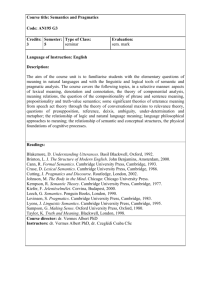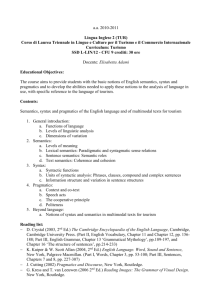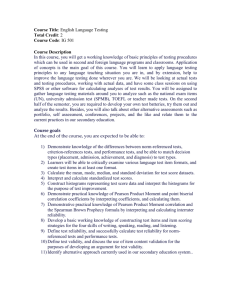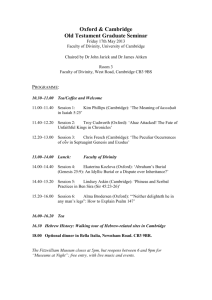Naziv studija
advertisement
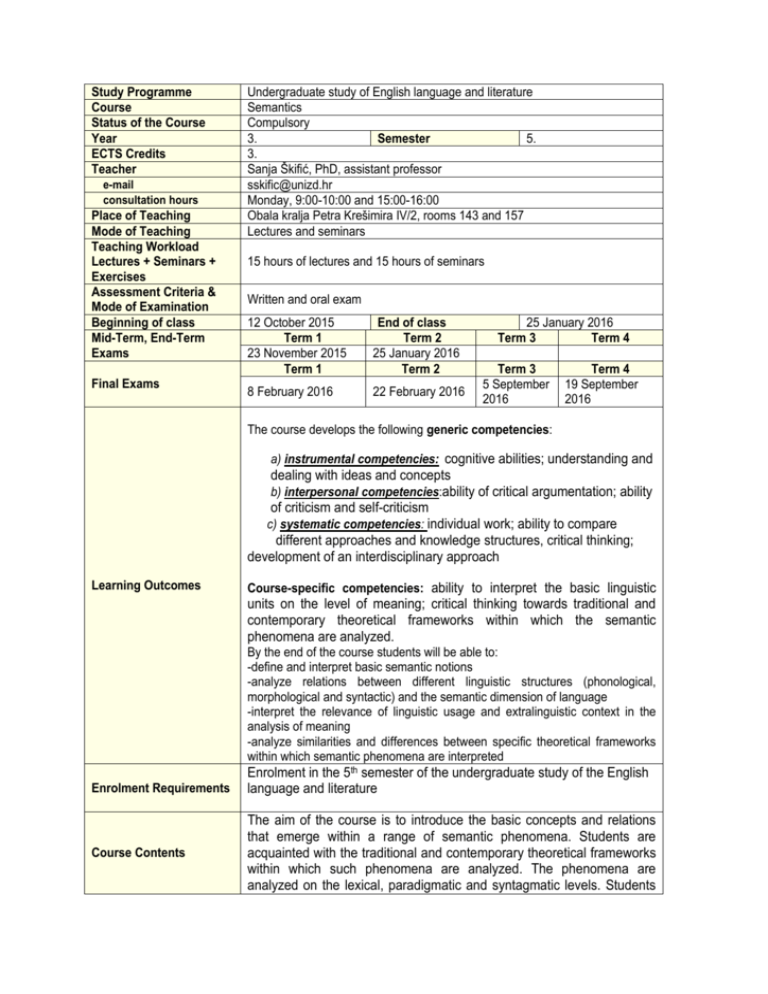
Study Programme Course Status of the Course Year ECTS Credits Teacher e-mail consultation hours Place of Teaching Mode of Teaching Teaching Workload Lectures + Seminars + Exercises Assessment Criteria & Mode of Examination Beginning of class Mid-Term, End-Term Exams Final Exams Undergraduate study of English language and literature Semantics Compulsory 3. Semester 5. 3. Sanja Škifić, PhD, assistant professor sskific@unizd.hr Monday, 9:00-10:00 and 15:00-16:00 Obala kralja Petra Krešimira IV/2, rooms 143 and 157 Lectures and seminars 15 hours of lectures and 15 hours of seminars Written and oral exam 12 October 2015 Term 1 23 November 2015 Term 1 End of class Term 2 25 January 2016 Term 2 8 February 2016 22 February 2016 25 January 2016 Term 3 Term 4 Term 3 5 September 2016 Term 4 19 September 2016 The course develops the following generic competencies: a) instrumental competencies: cognitive abilities; understanding and dealing with ideas and concepts b) interpersonal competencies:ability of critical argumentation; ability of criticism and self-criticism c) systematic competencies: individual work; ability to compare different approaches and knowledge structures, critical thinking; development of an interdisciplinary approach Learning Outcomes Course-specific competencies: ability to interpret the basic linguistic units on the level of meaning; critical thinking towards traditional and contemporary theoretical frameworks within which the semantic phenomena are analyzed. By the end of the course students will be able to: -define and interpret basic semantic notions -analyze relations between different linguistic structures (phonological, morphological and syntactic) and the semantic dimension of language -interpret the relevance of linguistic usage and extralinguistic context in the analysis of meaning -analyze similarities and differences between specific theoretical frameworks within which semantic phenomena are interpreted Enrolment Requirements Course Contents Enrolment in the 5th semester of the undergraduate study of the English language and literature The aim of the course is to introduce the basic concepts and relations that emerge within a range of semantic phenomena. Students are acquainted with the traditional and contemporary theoretical frameworks within which such phenomena are analyzed. The phenomena are analyzed on the lexical, paradigmatic and syntagmatic levels. Students are acquainted with basic semantic phenomena in class and through readings of literature relevant for a particular area of research. In the seminar part and on the basis of selected readings and exercises, they are encouraged to identify and analyze the same phenomena. Required Reading Additional Reading Internet Sources Course Evaluation Procedures Conditions for Obtaining Signatures Mark Grading Scale Final Grade Calculation Comments 1. Hurford, James R., et al. Semantics - A Course Book. Cambridge: Cambridge University Press. 2007. 2. Cruse, Alan D. Meaning in Language. An Introduction to Semantics and Pragmatics. Oxford: Oxford University Press. 2000. 3. Kreidler, Charles W. Introducing English Semantics. London & New York: Routledge. 1998. 4. Palmer, Frank R. Semantics – A New Outline. Cambridge: Cambridge University Press.1976. 1. Davis, Steven, and Brendan S. Gillon, eds. Semantics: A Reader. Oxford: Oxford University Press. 2004. 2. Cruse, Alan D. Lexical Semantics. Cambridge: Cambridge University Press. 1986. 3. Lyons, John. Semantics (Vol I and Vol II). Cambridge: Cambridge University Press. 1977. 4. Gregory, Howard. Semantics. London & New York: Routledge. 2000. Institutional evaluation Class attendance (70%) and accepted seminar paper. PERCENTAGE GRADE <60 1 >=60 2 >70 3 >80 4 >90 5 Students who pass both the mid-term and end-term exam do not have to take the written exam. Their final grade represents the combination of the results on the mid-term and end-term exam (mid-term exam – 40%; end-term exam – 40%) and the oral part of the exam (20%). Students who do not pass both the mid-term and end-term test have to take the final exam. Their final grade represents the combination of the result on the final exam (80%) and the result on the oral part of the exam (20%). Seminar topics should be discussed with the teacher individually during office hours. Students are required to hand in the first version of the seminar paper no later than two weeks prior to the beginning of the winter exam term. Seminar papers are to be written in accordance with the MLA style. Topics - Lectures No. Date Title Introduction to semantics as a linguistic discipline – A brief historical overview and relationship with other disciplines 1. Characteristics and types of linguistic meaning 2. Analysis of the linguistic sign (de Saussure, Ogden and Richards) 3. Reference 4. Sense relations I: Synonymy and antonymy 5. Literature Palmer, Frank R. Semantics – A New Outline. Cambridge: Cambridge University Press.1976. 1-16. Kreidler, Charles W. Introducing English Semantics. London & New York: Routledge. 1998. 1-8. Cruse, Alan D. Meaning in Language. An Introduction to Semantics and Pragmatics. Oxford: Oxford University Press. 2000.5-16. Palmer, Frank R. Semantics – A New Outline. Cambridge: Cambridge University Press.1976. 17-24. Kreidler, Charles W. Introducing English Semantics. London & New York: Routledge. 1998. 815; 49-51. Cruse, Alan D. Meaning in Language. An Introduction to Semantics and Pragmatics. Oxford: Oxford University Press. 2000. 43-63. Palmer, Frank R. Semantics – A New Outline. Cambridge: Cambridge University Press.1976. 24-29. Kreidler, Charles W. Introducing English Semantics. London & New York: Routledge. 1998. 1826. Palmer, Frank R. Semantics – A New Outline. Cambridge: Cambridge University Press.1976. 29-66. Kreidler, Charles W. Introducing English Semantics. London & New York: Routledge. 1998. 4246; 131-144. Cruse, Alan D. Meaning in Language. An Introduction to Semantics and Pragmatics. Oxford: Oxford University Press. 2000.21-28; 305-318. Palmer, Frank R. Semantics – A New Outline. Cambridge: Cambridge University Press.1976. 88-100. Kreidler, Charles W. Introducing English Semantics. London & New York: Routledge. 1998. 96113. Cruse, Alan D. Meaning in Language. An Introduction to Semantics and Pragmatics. Oxford: Oxford University Press. Sense relations II: Homonymy, polysemy and hyponymy 6. 7. Mid-term test Meaning of lexemes – componential analysis 8. Semantic fields 9. Metaphor and metonymy 10. Collocations and idioms 11. 12. 13. 2000. 167-176. Palmer, Frank R. Semantics – A New Outline. Cambridge: Cambridge University Press.1976. 83-87; 100-108. Kreidler, Charles W. Introducing English Semantics. London & New York: Routledge. 1998. 5259; 92-96. Cruse, Alan D. Meaning in Language. An Introduction to Semantics and Pragmatics. Oxford: Oxford University Press. 2000. 108-119. Cognitive semantics: categorization and prototype theory Semantics and syntax; semantics and pragmatics Palmer, Frank R. Semantics – A New Outline. Cambridge: Cambridge University Press.1976. 108-117. Cruse, Alan D. Meaning in Language. An Introduction to Semantics and Pragmatics. Oxford: Oxford University Press. 2000. 87-102. Palmer, Frank R. Semantics – A New Outline. Cambridge: Cambridge University Press.1976. 67-75. Kreidler, Charles W. Introducing English Semantics. London & New York: Routledge. 1998. 8792. Cruse, Alan D. Meaning in Language. An Introduction to Semantics and Pragmatics. Oxford: Oxford University Press. 2000. 179-196. Cruse, Alan D. Meaning in Language. An Introduction to Semantics and Pragmatics. Oxford: Oxford University Press. 2000. 74-76; 199-216. Palmer, Frank R. Semantics – A New Outline. Cambridge: Cambridge University Press.1976. 75-82. Cruse, Alan D. Meaning in Language. An Introduction to Semantics and Pragmatics. Oxford: Oxford University Press. 2000. 70-74; 76-80. Cruse, Alan D. Meaning in Language. An Introduction to Semantics and Pragmatics. Oxford: Oxford University Press. 2000. 127-142. Palmer, Frank R. Semantics – A New Outline. Cambridge: Cambridge University Press.1976. 135-154; 155-176. Kreidler, Charles W. Introducing English Semantics. London & New York: Routledge. 1998. 2640; 157-173; 175-196. Cruse, Alan D. Meaning in Language. An Introduction to Semantics and Pragmatics. Oxford: Oxford University Press. 2000. 267-299; 331-378. Palmer, Frank R. Semantics – A New Outline. Cambridge: Cambridge University Press.1976. 177-207. Cruse, Alan D. Meaning in Language. An Introduction to Semantics and Pragmatics. Oxford: Oxford University Press. 2000. 28-34. Meaning and logics 14. End-term test 15. Seminars No. 1. Date Title Differences between speaker meaning and sentence/word meaning Basic syntactic-semantic units – sentence, utterance, proposition 2. Components of word meaning – reference 3. Predicates and deixis 4. Literature Hurford, James R., et al. Semantics - A Course Book. Cambridge: Cambridge University Press. 2007. 1-16. Hurford, James R., et al. Semantics - A Course Book. Cambridge: Cambridge University Press. 2007. 16-25. Kreidler, Charles W. Introducing English Semantics. London & New York: Routledge. 1998. 6183. Hurford, James R., et al. Semantics - A Course Book. Cambridge: Cambridge University Press. 2007. 26-44. Palmer, Frank R. Semantics – A New Outline. Cambridge: Cambridge University Press.1976. 29-66. Hurford, James R., et al. Semantics - A Course Book. Cambridge: Cambridge University Press. 2007. 45-78. Palmer, Frank R. Semantics – A New Outline. Cambridge: Cambridge University Press.1976. 143-154. Kreidler, Charles W. Introducing English Semantics. London & New York: Routledge. 1998. 144-150; 251-266. Cruse, Alan D. Meaning in Language. An Introduction to Absolute synonyms; levels of differentiation 5. Distinguishing between homonymy and polysemy 6. 7. Mid-term test Decomposition of the meaning of lexemes 8. Types of semantic fields 9. 10. Traditional and cognitive approach to metaphorical meaning Contrastive analysis of collocations and idioms 11. Prototype theory and semantic fields 12. 13. Speech acts, perlocution, illocution, conversational Semantics and Pragmatics. Oxford: Oxford University Press. 2000.19-21; 319-327. Hurford, James R., et al. Semantics - A Course Book. Cambridge: Cambridge University Press. 2007. 105-127. Palmer, Frank R. Semantics – A New Outline. Cambridge: Cambridge University Press.1976. 83-87; 88-94. Cruse, Alan D. Meaning in Language. An Introduction to Semantics and Pragmatics. Oxford: Oxford University Press. 2000. 157-160. Hurford, James R., et al. Semantics - A Course Book. Cambridge: Cambridge University Press. 2007. 128-140. Palmer Frank R. Semantics – A New Outline. Cambridge: Cambridge University Press.1976. 83-87; 100-108. Hurford, James R., et al. Semantics - A Course Book. Cambridge: Cambridge University Press. 2007. 194-224. Palmer, Frank R. Semantics – A New Outline. Cambridge: Cambridge University Press.1976. 118-135. Cruse, Alan D. Meaning in Language. An Introduction to Semantics and Pragmatics. Oxford: Oxford University Press. 2000. 239-261. Palmer, Frank R. Semantics – A New Outline. Cambridge: Cambridge University Press.1976. 67-75. Hurford, James R., et al. Semantics - A Course Book. Cambridge: Cambridge University Press. 2007. 331-344. Hurford, James R., et al. Semantics - A Course Book. Cambridge: Cambridge University Press. 2007. 327-331. Palmer, Frank R. Semantics – A New Outline. Cambridge: Cambridge University Press.1976. 75-82. Hurford, James R., et al. Semantics - A Course Book. Cambridge: Cambridge University Press. 2007. 79-104. Hurford, James R., et al. Semantics - A Course Book. implicatures Cambridge: Cambridge University Press. 2007. 260-326. Palmer, Frank R. Semantics – A New Outline. Cambridge: Cambridge University Press.1976. 155-176. Hurford, James R., et al. Semantics - A Course Book. Cambridge: Cambridge University Press. 2007. 141-193. Palmer, Frank R. Semantics – A New Outline. Cambridge: Cambridge University Press.1976. 177-207. Logics and meaning 14. 15. End-term test Teacher: Sanja Škifić, PhD, assistant professor
